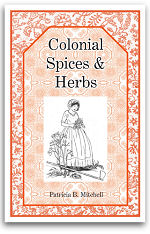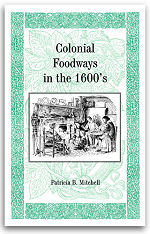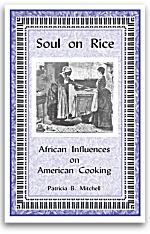








“Season the gravy very high,” advised Thomas Jefferson in a household recipe for beefsteak pie. Such instructions sound a bit vague to modern cooks, but the colonial kitchen-master no doubt understood how to proceed.
A recipe might state, “first make your coffin,” referring to the fact that “pyes” were baked in rectangular, narrow pans (“coffins”) similar to our loaf pans. The British adored their pyes, and of course when they settled in this country, whenever feasible, prepared comforting foods reminiscent of those served in merrie old England.
Favorite pies included those containing plovers' eggs, sparrows, robins, pigeons, pheasant, turkey, veal mutton, pork, “leman” rind, and dates.
A smaller version of the pie was the “pastie” or “pasty” or “fried pie” or “turnover.” These portable pies were handy (and tough-crusted enough) to slip into a saddlebag for journeying, and added variety to other travel fare like journeycake (or johnnycake) and corn bread.
When preparing savory colonial pies and pastries, the cook had but to step outside to the nearby herb garden to gather savory, rosemary, marjoram, sage, thyme, chives, garlic, onions, etc. In winter, dried herbs hung from the kitchen rafters ready for use. To add flavor and fat to the dry, lean meat of venison, elk, and moose, sugared racoon fat was utilized.
Other colonial flavor enhancers included an abundance of imported nutmeg, ginger, vinegar, and wines. Moreover, the basic flavor of olden-times meat and fowl was more distinct than much of that served today. After all, the fat hen destined to be the prima donna of the chicken pot pie had actually seen the light of day, eaten tasty earthworms and grubs, and known the attentions of a rooster.
Some food critics claim that early American foods were heavily spiced and seasoned to disguise rancid meat and dairy products, and old, dried-out vegetables and fruits. Though there were periods when hot weather did cause food to spoil quickly, and seasons of long winters when the stored root vegetables began to wrinkle from age, colonial meals were not normally dismal repasts of poor-quality foods disguised with herbs.
The prosperous colonists actually ate an enviable diet — home-grown, “organic,” whole foods; no chemicals, no peculiar-sounding additives. The preservatives used were natural, like salt, vinegar, and particular herbs. (Sage and rosemary are natural preservatives, and mustard seeds also inhabit the growth of mold, bacteria, and yeasts.)
In The Art of Cookery Made Plain and Easy by Hannah Glasse (1796), a recipe is represented “For Captains Of Ships" which is also billed as “very useful in Families.” This concoction is a heady mixture of ale, anchovies, shallots, mace, cloves, pepper, ginger, and mushrooms, and is entitled “To make Catchup to keep twenty years.”
No nasty added nitrates or nitrites in that list of ingredients! The colonial family was able to enjoy a nutritious diet, most of which was produced on their own land, the result of individual expenditures of time, energy, skill, and attention. That hearth-baked, steaming pot pie had not hibernated in the local supermarket's frozen food section, or suffered the abuse of a crowded check-out line food conveyor belt and the crushing constriction of a plastic grocery bag. Its experience was very personal and loving.